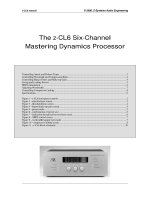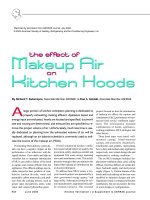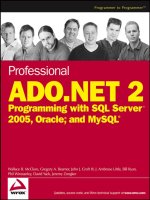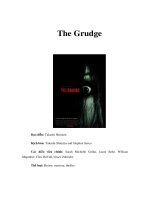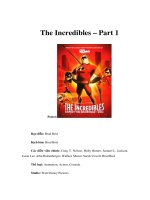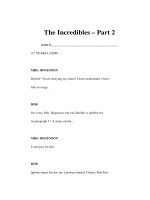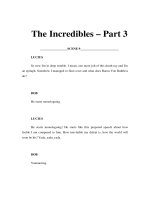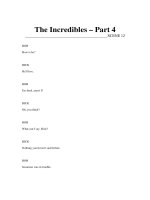Tài liệu THE ASIAN DIET Simple Secrets for Eating Right, Losing Weight, and Being Well docx
Bạn đang xem bản rút gọn của tài liệu. Xem và tải ngay bản đầy đủ của tài liệu tại đây (701.53 KB, 143 trang )
[
THE ASIAN DIET
Simple Secrets for Eating Right,
Losing Weight, and Being Well
[
THE ASIAN DIET
Simple Secrets for Eating Right,
Losing Weight, and Being Well
By Jason Bussell, MSOM, L.Ac.
© Jason Bussell 2009
The right of Jason Bussell to be identified as the author of this work
has been asserted by him in accordance with the
Copyright, Designs and Patents Act 1998.
First published by Findhorn Press 2009
ISBN: 978-1-84409-160-7
All rights reserved.
The contents of this book may not be reproduced in any form,
except for short extracts for quotation or review,
without the written permission of the publisher.
British Library Cataloguing-in-Publication Data.
A catalogue record for this book is available from the British Library.
Edited by Jane Engel
Cover design by Damian Keenan
Layout by Prepress-Solutions.com
Printed and bound in the USA
1 2 3 4 5 6 7 8 9 10 11 12 13 14 13 12 11 10 09
Published by
Findhorn Press
305A The Park,
Findhorn, Forres
Scotland IV36 3TE
t +44(0)1309 690582
f +44(0)131 777 2711
e info@findhornpress.com
www.findhornpress.com
j v i
Table of Contents
[
Preface vii
Chapter One Introduction to the Asian View on Diet 1
Chapter Two Grains 9
Chapter Three Vegetables 13
Chapter Four Fruit 19
Chapter Five Proteins: Meat, Fish, Poultry, Tofu 21
Chapter Six Soups 27
Chapter Seven Dairy 29
Chapter Eight Beverages 33
Chapter Nine Sugar Substitutes 39
Chapter Ten Supplements 43
Chapter Eleven What about Breakfast? 49
Chapter
Twelve Feeding our Children 51
Chapter Thirteen Food Preparation and Cooking Methods 53
Chapter Fourteen Tips for Losing Weight 57
Chapter Fifteen Lifestyle 59
Chapter Sixteen Attitudes 65
Chapter Seventeen Summary 73
Chapter Eighteen Basics of Oriental Medicine 75
Chapter Nineteen Actions of Common Foods 87
Chapter Twenty Recipes 115
Epilogue 121
S
upplemental Information 123
j i
j vii i
Preface
[
W
elcome to my book, which I hope you will enjoy. I also hope you learn
many things that will help you for the rest of your life.
Have you ever noticed the shape of the average American compared to that
of the average Asian? There are more obese people in America than any other
country and the problem is growing rapidly. This trend is the result of poor diet
and inappropriate lifestyles. Fortunately, we are finally waking up to what the
Asian cultures can teach us in terms of health care (acupuncture, herbology, tai
chi, etc.); now it is time to learn what they have discovered about eating and liv-
ing in balance.
The material that is contained in this book is information I try to instill in all
my patients. At the onset of treatment, I give them all a talk about adjusting their
diet, lifestyle, and attitudes in order to improve their health, mood, and longevity.
Many of my patients have asked where they could get this information in written
form and as I was unable to find such a resource, I wrote this book.
About me
I am an acupuncturist
and herbalist, trained in the United States and I also
completed advanced training and an internship in China. I am the President of
the Illinois Association of Acupuncture and Oriental Medicine and have a private
practice, together with my wife, in Wilmette, Illinois. Many astute people have
noticed that I am not Asian and often wonder how can a white guy practice
Oriental Medicine?
I earned a bachelor’s degree in psychology and worked in psychiatric hospitals
for several years before returning to school to study pre-med. As I was applying
to med schools, I was dismayed to learn how unhappy the doctors with whom
I worked were. I kept hearing “Don’t go into medicine. Do anything else. The
money is not there, the autonomy’s not there, the respect’s not there, and even
the patient contact isn’t there anymore. There’s no good reason to be a doctor.”
j i
viii j The Asian Diet
The first 20 times I heard it, I shrugged it off; but I kept hearing it and eventually
it got to me. Then a nurse with whom I worked told me about the acupuncture
program in town and though I had been interested in Eastern philosophy since
taking a course in high school, I had never considered Oriental Medicine (OM)
as a career.
I read some books about OM and found the whole paradigm pretty strange
and even a little suspect. I come from a family of physicians and was already pre-
med myself and I understand things like bacteria and viruses; but the Chinese
talk about things like “wind-cold invading the lung” and Qi. It was all so foreign
and different and I didn’t know if I could ever believe in the system. I figured I
could make a living at it because enough other people would believe. My skepti-
cism was very short-lived once I saw how effective this medicine is and how much
sense the philosophy makes. Now I love what I do. I get to spend a lot of time
with my patients, and I get to help them. In psychiatry, I worked pretty much
with a chronic population where very few people ever improved. With Oriental
Medicine, I am able to help almost all of my patients safely. Oriental Medicine is
the acquired wisdom of thousands of years of experimentation, observation and
documentation and with this historical perspective, much has been learned about
what works and what doesn’t. I am a grateful recipient of these lessons and now
I want to share this knowledge to help people take better care of themselves and
live longer and happier lives.
I have presented this information with many groups and patients and I know
that this system will be difficult for many people to work with at first. This book
presents guidelines and suggestions, but it does not tell you what to do. It is up
to you to decide how to implement the suggestions and create your diet. The
South Beach Diet was so successful partly because it told people exactly what to
do. Many of us like being given a strict structure to follow . . . for a while. But
after about 60 days we get tired of having no freedom and break from a prescribed
regimen. So I am just planting seeds; how they germinate is up to you. And, it is
not an all-or-nothing proposition. If you have a bad day, don’t give up, start again
so you can have more good days.
The opinions expressed in this book are just that – opinions and the book
makes no claims to being definitive or authoritative. The principles are written,
as I understand them, from my years of studying Oriental Medicine and Asian
culture. The ideas come from many different authors, speakers, researchers, teach-
ers, folk teachings, plus my own ideas of what makes sense. Other authors and
disciplines may disagree with some or many of the tenets I will present in these
pages. Therefore it is up to you, the reader, to decide whether or not this makes
sense to you. As far as I know, the Chinese have been studying nutritional therapy
longer than anyone else, so I tend to believe that they have figured some things
out in the past 4,000 years. The principles are simple:
• Balance and Moderation
• Cooked foods are better than raw
• Vegetables are better than fruit
• White rice is better than brown, but a variety is best
• Diet should be mostly plant-based, with grains and a little of everything else
• Simple foods are better than processed food
• Dairy is not necessary and can be harmful
• Do not over-fill your stomach
• Don't stress too much
• Exercise every day, but not too much
• Keep a wide perspective and don't sweat the small stuff
All these principles will be explained in more detail as you read the book.
What this book is and what it is not.
This is not a
weight-loss book, but it is about getting into balance by eating ap-
propriately. S
ome of my patients who do not need to lose weight are still very
much out of balance. If they are over-weight, that is in itself an imbalance. As you
get into balance, you will naturally shed the excess pounds and become more fit.
But even those who do not need to lose weight still need this information and
eating right will prevent or correct all types of disease and disorders. Our diet
choices are the most important and influential thing we can do to affect our daily,
and long term, functioning.
Chinese Dietary Therapy is a highly developed science and many people spend
their whole lives studying and practicing this. There are food cures for all types of
ailments, but that is not what this book is about. If you want to learn how to ad-
dress a certain ailment with diet therapy, please consult Chinese Nutrition Therapy
by Joerg Kastner and Anika Moje or Chinese System of Food Cures by Henry C. Lu
(unfortunately out of print but maybe you can find a second-hand copy). There
is also a great deal of information about the foods that we commonly eat and how
bad they are for us (and I could cite many studies on the subject), but that is not
what this book is about either. I present the basic guidelines for eating right and
most of us could greatly benefit from these simple changes. If you want to learn
what foods to eat to treat a particular disease, or if you want to know everything
there is to know about a particular food, read Healing with Whole Foods by Paul
Pitchford. To learn how we have been misinformed about diet and to peruse
Preface i ix
x j The Asian Diet
many studies on how harmful our standard food choices are, read The China
Study” by T. Colin Campbell. To learn the basics of eating right and being well,
however, read the book you hold in your hands right now.
Acknowledgments
Chin
ese medicine would be nowhere without building upon the work of others. I
would like to thank the entire lineage of Chinese medical practitioners for amass-
ing
this wisdom and passing it on; from the Yellow Emperor Huang Di, to Dr.
Hui-Yan Cai. I would also like to thank the Midwest College of Oriental Medi-
cine, my alma mater, for educating me and facilitating my study in China. Among
the modern-day authors who deserve a lot of the credit for the content of this book
are: Henry Lu, Bob Flaws, Kim Barbouin and Rory Freedman, T. Colin Campbell,
Joerg Kastner, Anika Mole, Ted Kaptchuk, Dan Bensky, Michael Pollan, and many
more. I would also like to thank my family for supporting my career choice, and
my wife for making me so much more than I ever was before her.
j 1 i
Chapter One
Introduction to the Asian View on Diet
[
A
sian medicine, like Asian philosophy, is all about balance, that is, finding and
maintaining balance as the goal of life. All pathologies can be thought of as
some type of imbalance; if you have a fever, you have too much heat; if you have
the chills you don’t have enough heat. It gets much more complicated than this,
but everything can be viewed as too much or too little of something. Oriental
Medicine (OM) can help bring a person back to balance. But my greater job as
a practitioner of OM is to teach my patients how to live in balance so that they
will not need continued treatment. The three greatest factors that get us out of
balance are our: Diet, Lifestyle, and Attitudes. The typical Westerner is almost
always out of balance in all three areas, sadly and our habits are spreading around
the world.
An ancient Chinese doctor once wrote that “In cases of disease and disorder,
the physician should first address the diet and lifestyle. If that fails, then you
proceed to the more heroic modalities of acupuncture and herbs.” Hippocrates,
the father of Western medicine wrote, “Let your food be your medicine and your
medicine be your food.” These days we have lost the sense of connection between
what we put in our bodies and how our bodies then function.
Oriental medicine is meant to be a preventive medicine and in the old days it
was common to pay the physician on a monthly basis; if, however, you became
sick, you would get a refund, for the doctor’s job was to keep you healthy, not to
help you recover from sickness. If you developed an illness or a disease, the doctor
had already failed you. Part and parcel of this agreement was the understanding
that the patient would follow the doctor’s orders. However, in the West, we are not
very good at following our doctor’s recommendations. In China they know that if
they follow the suggestions, then the problem will not become worse; and if they
don’t, then the problem will almost certainly progress. Today not enough attention
is paid to preventing disease and health disorders; but if we eat right, act right, and
think right, we can improve our health for our whole lives. We should all be able
to live to 100 years old and not suffer from obesity, heart disease, cancer, arthritis,
j i
2 j The Asian Diet
osteoporosis, Alzheimer’s, diabetes, high cholesterol, enlarged prostate, and all the
disorders that plague American seniors.
(Some people point out that many Asians do not live to be 100 years old.
However, they have other problems such as poor sanitation, parasites, and poverty;
and many do not follow the teachings. More and more Asians are embracing the
American lifestyle and diet . . . with regrettable results; but if more people followed
the principles outlined in this book, many more would reach the century mark.)
The first thing we need to do is change the way you think about food. We have
a dangerous disconnect in understanding how the things we put in our bodies af-
fect the way our bodies function. This is partly due to purposeful misinformation
in the advertising from the food manufacturers and partly due to our own denial.
It is time to take responsibility for your health for you are literally what you eat.
Our cells are constantly dying and new ones are being made and those cells are
made from the food we eat. If you were to build a house, you would choose to use
the best-quality lumber you could find. You will be in your body a lot longer than
any external structure, so when you are thinking about what to eat, ask yourself,
“What kind of a house am I going to build today?”
We cannot continue to ignore our bodies’ needs. Most of us pay more attention
to the maintenance needs of our cars than the needs of our bodies. If you put cheap
gas in your car and your car starts breaking down, you would change the gas. But,
when our bodies break down, we continue to use the same gas. The body’s needs
are very simple, requiring primarily a plant-based, varied, and mostly cooked diet.
There is no magic bullet. The keys are balance and moderation.
Western Dietary therapy is still in its infancy, so this is why people keep getting
fooled into believing that there is a magic bullet. “Everyone should eat granola!”
we were told, and then further research showed that too much granola was bad.
“Avoid fat and cholesterol and you will prevent heart disease!” but then we found
that some types of cholesterol are good and that a low fat diet does not prevent
disease. “Eliminate carbohydrates and eat meat to lose weight!” but we learned
that this type of diet causes long-term damage to the body. The Chinese have been
studying this for thousands of years and have learned that it is not any one thing
that we all need to eat or avoid – it is finding the proper balance of all things.
And they have found that this proper balance can be maintained by eating mostly
cooked vegetables, simple grains, plus a little bit of almost everything else.
Let me be clear: there is no one thing that is the key–not fat, calories, sugar,
grapefruit, protein, carbs, sodium, trans-fat, supplements, nor any one thing; it is
all things and how they combine to form a whole.
Chinese dietary recommendations differ from those that we learn here in the
West and some of the recommendations in this book may seem like blasphemy
after what you have been taught. I am sorry, but you cannot trust what the gov-
ernment and what your doctors tell you about nutrition. The food industry is
thoroughly in bed with the government and makes sure that all dietary recom-
mendations that are released promote their foods. There are conflicts of interest
at all levels of the FDA, USDA, National Institute of Health, the Department of
Health and Human Services, and the Department of Education. From kinder-
garten through senior year of high school, most children have two choices for a
beverage with their lunch – milk and chocolate milk. And the dairy board gets to
decorate the cafeterias with its ads portraying milk as a healthy food. What other
industry is allowed such access to directly lobby our children?
And they get to educate our doctors too. In the entire four years in medical
school, the average doctor receives just 21 hours of education in nutrition, and the
educational materials are often created and provided by the dairy, meat, and snack
food industries. What do you suppose these industries want to teach doctors about
their products? When scientists stand up to the system and fight for what is right,
they are discredited and bullied out of the industry. Doctors are not being evil or
negligent, they just tell you what they were taught by those who have products
to sell. For example: “Diet does not affect health”, “Dairy is good”, “Eat a lot of
meat”, “Supplements can replace whole foods”, etc., and the doctors are usually
unaware that their education has been provided by special interest groups.
Chinese culture has state-supported health care, so it is in their best interest to
teach the people how to be well. In America, health care is a for-profit endeavor
and the more sick people there are, the more money there is to be made. I don’t
mean to sound alarmist or conspiracy-inclined, but it is true; the food and health
care industries have so much money and they have tainted the systems that we
count on to ensure our safety. You cannot blindly trust their recommendations.
The food choices you make are probably the most influential things you can
do to help or hurt yourself on a daily basis. People say they don’t have time to
cook, or to shop, or prepare good food and they argue that poor nutrition is one
of the sacrifices of a modern lifestyle. We have to make it a priority. I also hear,
“Everything will kill you, so let’s enjoy ourselves now.” However, I plan to enjoy
my life for a full 100 years and I don’t want to be saddled with excess weight and
health problems. Let’s face it, eating bad and artificial food is not the only thing
we are here to enjoy.
The development of Asian Dietary Therapy
A long time ago, humans found themselves here on this planet. A couple of hours
later they found themselves here and hungry, so they started eating things. Then
Chapter 1: Introduction to Oriental Medicine and Diet i 3
4 j The Asian Diet
they noticed that different foods affected them in different ways: “That leaf makes
me tired, this one make me feel awake; this seed gives me diarrhea, this fruit stops
the diarrhea,” etc. The real treasure of the Chinese culture is that it is a 4,000
year long experiment with careful record keeping and dissemination of the les-
sons learned through written language. They never had a Dark Age. Throughout
their history, the Chinese have experimented with different dietary and lifestyle
choices. When they found things that worked, they spread the word; when they
found things that didn’t work, they also spread the word. We are the fortunate
recipients of the knowledge gained over 4000 years of experimentation, observa-
tion, and documentation of the lessons learned by some of the greatest minds in
Asia’s history. Most of the West’s classical knowledge was lost with the fall of the
Roman Empire. It is only since the Renaissance that we have started rebuilding
our knowledge base, so our knowledge is only about 400 years old.
At its core, Oriental medicine is all about balancing Yin and Yang. This con-
cept will be explained further in Chapter 18, but for now you should know that
Yin and Yang is a way of understanding everything in the universe as lying be-
tween two extremes: Yin is the cool, quiet, dark energy of things while Yang is the
hot, active, light energy. Too much or too little Yin or Yang are forms of imbalance
and can manifest as all types of symptoms, including obesity.
You do not need to eat Asian food to follow these principles. In Asian cultures,
a great variety of foods, spices, and preparations are included in each country’s diet.
But there are some commonalities and you can and should adapt these concepts to
fit your environment. For instance, look at the way typical Asians behave:
• They eat a lot of grains
• They eat a lot of vegetables
• They don't eat a lot of raw foods
• They don't eat a lot of meat
• The eat a lot of whole foods
• They have few sweets except for a little bit of fruit
• They have soup with most meals
• They have tea with most meals
• They have few baked and processed foods
• They do not consume dairy
• They exercise every day
• They do not get too emotional or stressed
If we incorporate these principles, we will develop the physique of the typical
Asian, which is lean. Unfortunately, when Asians come to America and adopt our
dietary ways, they develop the shape (and health problems) of the typical Ameri-
can. Diet is more important than genetics in determining our size, shape, mood,
health, and longevity.
Don’t let your tongue dictate your diet
Food stays on
your tongue for one to two minutes but your digestive organs
wrestle with that material for 48 hours (normally), and the tissues that are created
from that food stay in the body for weeks or months. So the tongue can have a
vote, but it shouldn’t have the only vote. We all tend to include plenty of sweet
and salty tastes in our diet, and sweet has a tendency to create dampness (which is
how the Chinese understand excess weight) and salty causes water retention. The
Chinese recognize five flavors: sweet, salty, sour, bitter, and acrid. Each flavor has
a distinct effect on the individual, and each one corresponds to an internal organ.
We have to feed all the organs in our bodies, not just our taste buds. If we don’t
have enough of all the tastes represented, we will be pulled out of balance.
All foods and herbs have properties and some properties are warming, cool-
ing,
moistening, activating, or sedating, etc. Through the considerable study of
these properties and the continual recording of results over the centuries, the
Chinese have come to understand the actions of food. So, in Asia, the properties
of foods are taken into account when planning meals. In addition, there are some
foods that are not eaten at certain times because they are contra-indicated; for
example, women will not eat cold or raw foods after childbirth because digesting
it steals too much of their body energy. Also, some foods are only consumed in
certain seasons.
A note about calories: Calorie counting is a flawed concept and I can’t
believe that no one has pointed this out yet. Calories are different from energy
and we want to get all the energy from the food we can and thus we’ll then be ani-
mated and active and able to burn the calories. But we don’t really have to concern
ourselves with the calories at all.
In the West, calories in a particular food are determined by burning it in a
laboratory with a device called a calorimeter. Then the amount of energy that
is released as it is burned is measured. The theory is that the amount of energy
released by breaking it down via fire in the lab is the same as would be released by
breaking it down with enzymes and digestion in the body. Now these are two very
different processes and could most likely yield different results, as many things be-
have differently in a lab. Even though I’m not convinced that the calorimeter gets
a valid assessment of the energy we get from the food, let’s assume it is true. So if
a bagel has 200 calories worth of energy in the lab, eating that same bagel will put
200 calories into you according to this theory. The thing is, not all of that bagel
Chapter 1: Introduction to Oriental Medicine and Diet i 5
6 j The Asian Diet
stays in you. When we move our bowels, we excrete the leftover, unused portion
of the food and this has caloric value as well. If we burn the feces, we can measure
how many calories we have passed. So the true measure of calories retained would
be: calories put in minus calories passed minus calories burned. I am not suggest-
ing that we all start burning our feces; I am just pointing out that the number of
calories ingested is not the whole story. For instance, if someone is suffering from
dysentery, it doesn’t matter how much food they eat, they’ll not hold on to any
of it. The average Chinese person consumes from 25-40% more calories than the
average American; even the most sedentary office workers consume more calories
and are less obese than we are. You do not need to count calories and you should
never go hungry. The goal here is efficient digestion.
A key difference between Eastern and Western thought
Western philosophy tends to be reductionistic, i.e., breaking everything down to
its smallest parts, while Eastern philosophy is holistic, understanding how things
relate to the whole. Each has advantages to offer, but each has limitations. Imagine
trying to understand the hand by chopping off the arm and studying the hand
alone on a table. It would not make a whole lot of sense without knowing about
the muscles and nerves and tendons and blood supply necessary to make it work.
Western dietary therapy treats food as nothing more than the sum of its parts,
whereas Eastern nutritionists understand that it is how things are combined that
matters. So we don’t worry about the grams of fat, protein, carbohydrate, sugar,
etc., we simply think about the whole food and how it fits into the whole diet.
By the way, it is only recently that we have looked to science to tell us how
to eat. Coincidentally, since then we have become more obese and have more
diet-related disease. The interactions of complex foods with our complex bodies
is much more intricate and involved than we can understand easily. Therefore,
we should trust what thousands of years of culture have taught us. We should eat
what our mothers and their mothers ate.
Some people say, “Our diet must be OK because we have a longer average
lifespan than some countries in Asia”. Do not confuse lowered infant mortality
and life-prolonging medical care with wellness. We now have more diet-related
illness than we have had in the past 200 years.
A note on whole foods
“Whole foods” means using the entire food as opposed to just a single part and
this is how the term is used to describe brown rice as a whole food. Oftentimes,
one part of a food will have a particular action and the other part will have the
opposite reaction. For example, Ephedra stem encourages sweating, while Ephedra
root stops sweating. Citrus fruit engenders phlegm and dampness in the body and
the peel of a citrus fruit resolves phlegm and dampness. I don’t expect people to
start eating citrus rind, they don’t in China either; but you can put it into a tea
and absorb its benefits that way. I find the case of grapes very interesting, because
for years now, the growers have manipulated the grapes to grow with no seeds.
Yet, the main ingredient in antioxidant pills is grape seeds! If we were not taking
grape seeds out of our diet, we would not need to put them back in. Every food
is balanced and has both Yin and Yang aspects and if we only eat part of a food,
we are eating an unbalanced food. This is fine in moderation, but over time our
bodies become out of balance.
Whole foods can also refer to an entire part of the plant that is unprocessed.
Corn is corn. Corn that is ground down and mixed with soy lecithin, oil, salt, col-
ors, additives etc, is no longer corn and is not a whole food. Nowadays we tend to
think (and talk) about a food as nothing more than its constituent parts. “You need
some Vitamin C; you should eat more protein, eat less fat, etc.” Instead, we should
start talking more about the whole foods. “You should have some nuts, you should
have an orange, you should eat less meat and dairy, etc.” Whole foods are balanced.
They are immensely complex and work best when in their whole form.
Fortified foods are foods that have been stripped of their natural nutrients but
have had a select few re-introduced. Western, reductionistic science thinks that
only a few parts of the whole are important (and therefore worth the cost of re-
introducing). The analogy I have for this is a wardrobe: I am going to raid your
wardrobe and take everything out of it, but I will only put back three items. Now,
that’s basically the same, isn’t it? Of course not. So we must eat more whole foods.
Fortified is better than non-fortified, but the whole food is far, far, superior.
Simple foods are better than those that are man-made and engineered. Tosti-
tos
®
are made with corn, corn oil and salt, but to add the “touch of Lime,” about a
dozen ingredients have to be used. Lays
®
potato chips have sliced potato, oil, and
salt. Baked Lays potato chips again require the addition of about a dozen more
manufactured ingredients. Now, chips are not good for you and you shouldn’t
have them often and I only point this out to illustrate how a pretty simple recipe
can be bastardized. I’m sorry, but we all need to start reading labels.
And I think it should go without saying, but please Avoid Fast Food, which is
so processed, artificial, and unhealthy that to have it any more than once a month
is too much. Even if they say it is low fat, or even “organic,” don’t be fooled into
thinking it’s healthy. Fast food is not healthy and it will make you fat, so it is best
to avoid it completely.
Chapter 1: Introduction to Oriental Medicine and Diet i 7
However you change your diet or lifestyle, you should do so slowly and
gently. If you try to change too much too fast, you will set yourself up to fail
and you’ll also shock your system. Detoxifying diets, liquid diets, fad diets, fast-
ing diets, Atkins, South Beach, the chicken diet, etc., are neither balanced nor
moderate. The best way to get into balance is to live a little more in balance
today than yesterday, and not to grossly overcompensate for yesterday’s mis-
takes. You did not get out of balance overnight, and food changes will not show
improvement for a while. You do not need to detox, you just have to stop toxing.
The toxins will work their way out of your system eventually as long as you stop
replacing them. Do not make drastic changes; just try to do a little better this
week than you did last week.
There are five main branches of Oriental Medicine: Acupuncture, Massage,
Herbology, Dietary Therapy, and Exercise (tai-chi and Qi-gong). Dietary therapy
is the best one to focus on because it is the most profound way we influence our
bodies each and every day, whether we are aware of it or not. Most of my pa-
tients do not come to me in a state where a simple food change will be enough
to correct their problem. But if we recognize that the diet, lifestyle and attitudes
are at least partial causes of our disorders, then there is more we can do to help
ourselves. Plus, if diet and lifestyle contributed to the development of a problem,
then things will surely get worse if we do not change.
NOTE: For more in-depth information on Oriental Medicine, please see Chapter 18,
where I elaborate on this topic.
8 j The Asian Diet
j 9 i
Chapter Two
Grains
[
I
f carbohydrates were bad, most of Asia would not be thin. There is much re-
search to show that a diet high in complex carbohydrates is the healthiest diet
and one that is capable of reversing heart disease and diabetes. Most of our carbo-
hydrates should come from grains, fruits and vegetables. Complex carbohydrates
come from whole food products and break down appropriately in the body. Re-
fined grains, such as white flour, are stripped of their nutrients and deliver sugar
too fast to our bodies. Crackers, cookies, breads, and pastas (made with refined
and/or bleached white flour) are not good sources of carbs.
Of the grains, white rice is the best. White rice has been much maligned in
the public consciousness lately and has been lumped in with white bread, white
sugar, and iceberg lettuce as a food devoid of value. Meanwhile, brown rice has
been getting all the positive press. In general, I advocate eating whole foods with
rice as somewhat of an exception.
Brown rice is white rice, with a thick coating around it. This shell is known as
the germ layer, or bran, and this layer is what is “polished” off in making white rice.
When analyzed in the lab, this germ layer is found to have some fiber and vitamins;
but they have a poor bioavailability and most of it will just pass through us. Fiber
is indigestible and just adds bulk to your stool. You can, and should, get all the
vitamins and fiber you need from vegetables and fruits. Brown rice and white rice
have roughly the same number of calories, but brown rice has more fat.
Eating the rice with this germ layer is a little like eating a walnut and not
taking off the shell. Of course, nature had to put some nutrients into that coat-
ing to create it, but those nutrients are not very accessible to us. Our bodies will
spend a great deal of time (largely unsuccessfully) trying to break through the
covering and most of the material will eventually pass through us resulting in a
loss of energy and a slowing of our metabolism. A little bit of brown rice can be
helpful for certain types of constipation because the extra fiber helps bulk up the
stool; but too much brown rice can actually exacerbate constipation by slowing
the metabolism.
j i
10 j The Asian Diet
Brown rice was popularized with the macrobiotic movement and studies were
carried out using brown rice as it is found in Japan, which is partially milled:
that is to say that about 75% of this germ layer has already been removed. The
brown rice that we get here in the United States is completely unshucked, so
unless you are going to mill it yourself, brown rice will be a tall order for your
body to digest.
The Chinese eat almost everything, including a lot of things that we would
scoff (or even retch) at the mere thought of eating. When I was studying in China,
I ate snake, pork kidneys, sea cucumbers and beef testicles, to name a few. So the
fact that the Chinese go to the trouble to polish off the germ layer of brown rice
indicates there must be a good reason: they found that it is easier to digest. If
removing the germ layer of brown rice had led to a deficiency, the Chinese would
have figured that out by now.
White rice is the most hypo-allergenic, easily assimilated, and energetically
neutral of the grains. As I mentioned in the last chapter, all foods and herbs have
properties – some things are warming or cooling, moistening or drying, activating
or sedating, etc. White rice is completely neutral, so you could eat it all day, every
day, and it would not throw off your internal energetic balance. It is true that it
does have a high glycemic index, so persons with diabetes should exercise greater
moderation and so white rice, like all things, should not be over-consumed.
White rice is also a very good first food to give to babies, being hypoallergenic
and easy to digest and it has no gluten. After long illnesses and after traumatic
events, patients in China are often given rice soup, called congees, to help with
recovery. Normally, cooking rice calls for two cups of water to each cup of rice. To
make a congee, use eight cups of water for each cup of rice and cook it for at least
three to four hours over low heat. Congees can be served plain (translated bland),
or they can be made sweet or savory. To sweeten it, you can add brown sugar,
honey, raisins, bananas, etc., as you would with oatmeal. To make it savory, mince
some meat, brown it and add some scallions, garlic, ginger and a pinch of salt.
So white rice is the best, but you shouldn’t have it every day. All foods have
things that are good and bad about them and every food has something that
nothing else can give you. Another important principle of Asian food therapy
is: A good diet should be like a good stock portfolio – diversified. If you have
the same thing every day, or even every week, you are loaded up in one sector.
This makes you more prone to the negatives of that sector, and at the same time,
you are missing out on all the other good things happening in the market. So like
a good portfolio, you should hedge your bets. All foods pull us in a particular
direction and if you have just a little bit of different foods in your diet, nothing
can pull you too far out of balance. Too much of any one food is not a good idea,
and too little of any particular food is also not a good thing either. So you should
include all the grains that are available in your diet: barley, millet, couscous, qui-
noa, flax, oats, rye, buckwheat, corn, job’s tears, spelt, hemp seed, and sorghum.
Even brown rice should be included in moderation. Actually, modern refining
techniques are now much more effective than in the old days. In the past, white
rice would have more of that germ layer left on it and that was good. For this
reason, therefore, it is good to have some brown rice in your diet.
Not surprisingly, gluten intolerance is a growing problem, and it makes sense
that too much of any one thing is not a good thing. For instance, we have been
overdosed on wheat as it is used as filler for many processed foods such as crack-
ers, cookies, and snack foods. And this same overdosing is also beginning to occur
with soy, as soy lethicin is being injected into more processed foods. Thus the
reason why whole foods are better is because you know exactly what is in them.
Therefore, a general rule with all foods is: the more processed a food is, the
more difficult it is to un-process. Rice is popped out of its shell and steamed;
wheat is popped out of its shell, then ground, mixed, heated, kneaded, leavened,
and baked to make bread. This obviously takes a few more steps than rice, as does
pasta. This is not to say that breads or pastas are bad, they are just a little more
difficult for us to process and should represent a smaller proportion of our weekly
intake. I have no idea how many steps are involved in making a Twinkie
®
, but
I’m sure it’s a great many! So Twinkies should really be kept at a minimum; and if
you are trying to lose weight, you should avoid breads and pastas (and Twinkies)
as much as possible.
The more robust your constitution is, the more you may be able to get away
with eating processed foods. Some people can handle difficult-to-digest foods
better than others, for a while. But remember, you either boost or injure your
constitution every day with the food choices you make. Don’t take good health for
granted. Simple foods are simple to digest; and we want efficient digestion.
Chapter 2: Grains i 11
j 13 i
Chapter Three
Vegetables
[
T
he bulk of your diet should be vegetables and when compared with the Asian
diet, our meals are unbalanced in America. We tend to eat a large protein,
a small vegetable, and a small starch for our meals. Instead, we should be serving
a large vegetable, a small protein, and a small starch. In fact, there is protein and
starch in vegetables anyway, so you can eat all the vegetables you want and you
should never go hungry.
Commercial over-farming has taxed the land of much of its nutrients and not
all vegetables are created equal. Try to buy organically grown foods as often as you
can. Local farms tend to use more sustainable methods and fewer chemicals than
the big industrial farms, plus the vegetables are fresher and do not need to be pre-
served in transport. As a result, the foods have more nutrients and they contain a
lot more life. Food that is full of life will give you life. Non-organic food is not bad
for you; it is just not nearly as good for you. Pesticides and man-made fertilizers
are very bad for you. Over the past 50 years, the USDA has noted a decline in the
nutritional content of our produce, which should alarm us all. Could it be that we
are eating more because our foods do not sufficiently nourish us?
We are also losing the diversity of vegetables in the pursuit of commercial
farming profits. There are dozens of varieties of broccoli, but the agribusinesses
only cultivate one. They are selecting and cultivating crops based on their yield,
not on their quality or nutritional content. Genetic modification is altering our
foods in ways we do not fully understand, and it is possible that we will lose the
original foods as they are replaced by engineered variants. There is an excellent
project called Seed Savers, which is trying to preserve seeds of all the un-altered
produce in the world. Without intervention like this, it is possible that our only
choices for produce in the future will be genetically modified ones. Please visit
www.seedsavers.org and lend support to this important project.
Remember that you are constantly rebuilding your house and just as you
would when rebuilding your home, you would naturally use the best materi-
als available. And it is the same when you are rebuilding your body – you need
j i
14 j The Asian Diet
high-quality material and this means organic. Organic, organic, organic. Better
yet, grow your own vegetables (without pesticides or man-made fertilizers), and
use heirloom seeds.
Cooked vegetables are better than raw. There are raw-food proponents out
there who argue that, “Cooking a vegetable destroys all its nutrition.” This is not
true if that vegetable is cooked correctly. Lightly steaming or sautéing a vegetable
does destroy about 10% of the nutrients, but the remaining 90% is then unlocked
and available. Everything cold and raw that you put in your stomach has to
be heated and cooked internally by you. This takes your body time and energy,
and slows your metabolism. Calories, however, are a different concept than en-
ergy. The average Chinese person consumes 25-40% more calories per day than
the average American. So it is not only the number of calories you eat, but how
your body handles them. We need to get all the energy we can from our food so
that we can then be active and burn up all the calories and eliminate the ones we
don’t need. As we get almost all of our energy from the food we eat, we don’t want
to spend too much energy processing this food. Otherwise it is like taking out $10
at an ATM and paying a $2 fee for doing so.
At one time there used to be some misinformation circulating about celery,
which you may have heard that said celery was a ‘negative food’ because it costs
more calories to process than it gives you, so you can eat it all day and you’ll
lose weight. Now, that would be great if it worked that way, but it doesn’t. This
will impair your digestion and slow your metabolism and is obviously inefficient.
What we want is efficient digestion. We want our digestive tract to be like a
filter – sending the good material to the tissues and the waste to the tissue paper.
We don’t want to expend too much time or energy having our bodies cooking that
food. So we cook our food outside the body and lighten the load on our diges-
tive tract, thus speeding up our metabolism in the process. The less efficient our
digestion is, the more food our bodies will ask for.
In America, we tend to think that a salad is the healthiest thing we can eat. We
all know someone who is trying to lose weight, who eats a big salad everyday, and
yet is not losing weight. For one thing our salads can be incredibly bad for us with
all the bacon, dressing, cheese, eggs, etc. that get piled on them sometimes. But
even if the salad consists of just a plate of raw vegetables without dressing, that
meal is too difficult to digest. Eating a small salad every now and then is fine, but
a big salad every day is too much. The cell walls of plants are thick and are well
defended, so cooking is a form of pre-digestion, which unlocks the nutrients.
Another way to pre-digest food is with fermentation. Asians pickle a lot of veg-
etables and eat them over the winter when fresh ones are not available. I wouldn’t
suggest eating pickled vegetables all the time, but they are good to add to your

